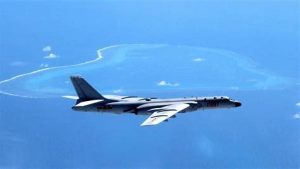On Wednesday, the Chinese military reported that its warplanes closely trailed a U.S. Navy surveillance aircraft over the Taiwan Strait, the channel situated between mainland China and Taiwan. The Taiwan Strait, a contentious area within the South China Sea, has become a focal point of disagreements, with China asserting its jurisdiction over the waterway and the U.S. considering it international territory.

Senior Colonel Shi Yi, a spokesperson for the People’s Liberation Army, denounced the U.S. Navy’s decision to fly the aircraft over the Taiwan Strait as a “provocative move,” emphasizing the perceived provocation in a statement released by the Chinese military. According to the military’s news release, the Chinese PLA Eastern Theater Command promptly organized warplanes to legally track and monitor the U.S. aircraft’s passage, underscoring their commitment to defending China’s sovereignty and regional peace.
The U.S. Navy aircraft in question was identified as a P-8A Poseidon spy jet, designed by Boeing for maritime surveillance, search and rescue operations, and anti-submarine warfare. Notably, this military aircraft is a military adaptation of Boeing’s 737 passenger jet, the same model that recently gained international attention for overshooting a runway in Hawaii and becoming lodged in a bay for an extended period.
U.S. Navy officials officially acknowledged the plane’s transit over the Taiwan Strait, asserting that it traversed through international airspace. The U.S. 7th Fleet, stationed in Japan, affirmed the operation’s adherence to international law, asserting the United States’ commitment to a free and open Indo-Pacific region.
China’s practice of deploying fighter planes to shadow, and sometimes intercept, U.S. military aircraft and vessels in the region is not uncommon. Instances of such encounters have escalated tensions in the past, with close calls and risky maneuvers reported.
Last December, a Chinese fighter jet approached within 20 feet of a U.S. Air Force jet flying over the South China Sea, leading to evasive actions by the U.S. military to avoid a collision. In June, China’s defense minister justified intercepting a U.S. and Canadian naval passage through the Taiwan Strait, arguing that freedom of navigation patrols were deemed provocative. In response, the Pentagon declassified images and videos in October, revealing multiple instances of Chinese jets engaging in “coercive and risky” maneuvers near U.S. jets in the Indo-Pacific region, characterizing it as part of a broader campaign to alter U.S. operations in the area.

